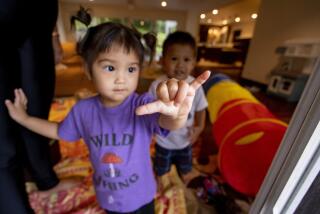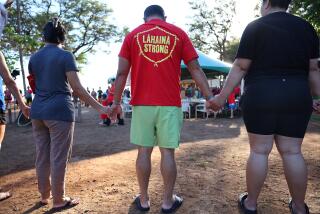The Hula, as Sacred Dance, Is Allowed During Mass
- Share via
HONOLULU — Psalm 149 lives again in Hawaii’s Catholic churches.
After months of negotiating with the Vatican, Honolulu Bishop Francis X. DiLorenzo is allowing hula and other Native Hawaiian “sacred gestures” to be performed during services.
Rome banned these central elements of the Hawaiian culture from local churches earlier this year after a resident complained they were being used for entertainment and not worship.
DiLorenzo went to Rome this summer to appeal Hawaii’s case, likely using Psalm 149 as evidence: “Let them praise his name in the dance.”
This week, with the Vatican’s approval, DiLorenzo issued new guidelines for allowing sacred gestures during Mass. They take effect Jan. 3.
“Sacred gesture is a way for Pacific Islanders, Asians and those who have embraced the culture to worship as baptized Catholics,” DiLorenzo said in directives mailed to all 66 parishes in the islands. “For many, their cultural and religious experience are interwoven.”
DiLorenzo specifically avoided the word “hula” because other cultures here--Asian, Filipino, Samoan and Tongan, for example--use native expressions during Mass, diocese spokesman Patrick Downes said.
Of the 1.2 million residents of Hawaii, about 730,000 are Pacific Islanders or Asian. Of those, about 215,000 are Catholic, Downes said.
But it was a Maui church’s use of hula that hatched the controversy. At least 200,000 people in Hawaii claim some Hawaiian ancestry.
Hula uses the hands, body and feet to tell a story. Ancient Hawaiians danced for their kings in both religious and secular settings.
The dance now is performed during all types of church services, including First Communion, weddings and funerals, by both men and women. It even was performed at DiLorenzo’s installation as bishop.
The dance can be accompanied by religious chanting and the playing of native instruments such as the ipu, a drum made from gourds, and nose flute. It is more likely to be part of a church service in a parish populated by Native Hawaiians.
Church officials stress that hula performed during liturgies is not the same as hula performed by women wearing coconuts, leis and grass skirts at the famous Kodak Hula Show.
John K. Lake, a kumu hula, or hula teacher, for more than four decades, said church hula is performed in the “strictest, most beautiful, spiritual sense.”
“Some movements are done in church only and wouldn’t be done outside the church,” Lake said. “The dance changes according to the knowledge that’s presented in the context.”
Last year, a Maui woman was offended by a hula performance during Mass and complained to the diocese. She then took her complaint to Rome.
In June, Sister Mary Lange of the diocese’s Office of Worship told parish priests the Vatican said, “there should be no dance of any kind in the churches of the Diocese of Honolulu.”
That touched a nerve among Hawaiians, whose language and cultural practices were banned by New England missionaries in the 1820s.
Hula was banned from public and private performances because it was considered “enchanting,” Lake said.
“With the missionaries, anything Hawaiian was debasing Christianity,” he said. “Everything that was Hawaiian in regards to traditions were considered valueless.”
Hawaii newspapers also criticized the Vatican’s ban.
“Clearly, if the church is to continue to be relevant in an increasingly cynical age, it cannot keep itself at a distance from the people it serves by sending down orders that deny an important part of their culture,” The Honolulu Advertiser said Dec. 8.
DiLorenzo said the church’s ban on “dance within the liturgy” remains in effect “as entertainment has no place within the sacred liturgy.”
But sacred gesture--defined as movement that expresses praise, thanksgiving, adoration, petition and penitence--is permitted during designated Masses, at certain times in the ceremony and with appropriate attire.
“This form of gesture is considered as a form of praying with one’s whole being,” DiLorenzo said.
Native expression and dance during Catholic services is used by churches in Africa and Oceania, and sometimes is performed for the pope.
Just last month, bare-chested, barefooted tribespeople performed for Pope John Paul II during a Vatican synod for bishops from Oceania.
The pope told worshipers then that the church is “searching for new impulses . . . in the drive to announce the kingdom of Christ in the diversity of culture and of human tradition, social and religious, and in the marvelous multiplicity of their people.”
More to Read
Sign up for Essential California
The most important California stories and recommendations in your inbox every morning.
You may occasionally receive promotional content from the Los Angeles Times.













